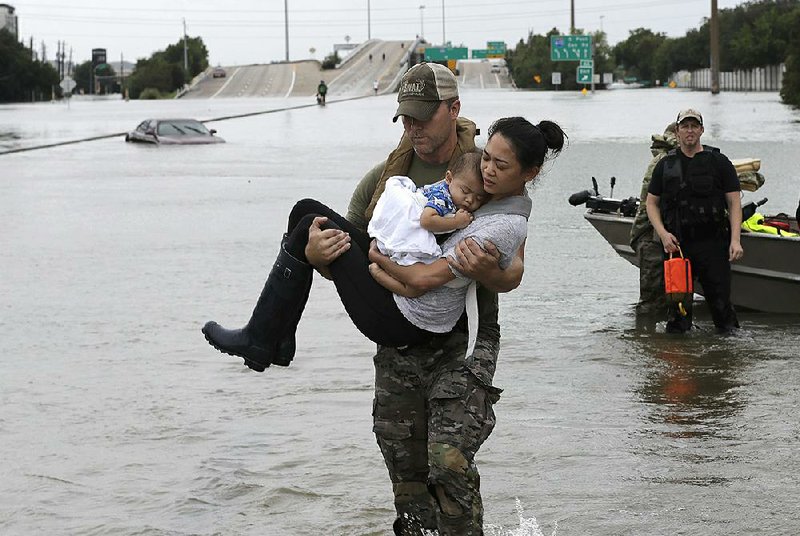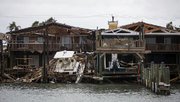HOUSTON -- Tropical Storm Harvey sent devastating floods pouring into the nation's fourth-largest city Sunday as rising water chased thousands of people to rooftops or higher ground and overwhelmed rescuers who could not keep up with the constant calls for help.
The incessant rain covered much of Houston in turbid, gray-green water and turned streets into rivers navigable only by boat. In a rescue effort that recalled the aftermath of Hurricane Katrina, helicopters landed near flooded freeways, airboats buzzed across submerged neighborhoods and high-water vehicles plowed through waterlogged intersections. Some people managed with kayaks or canoes or swam.
Volunteers joined emergency teams to pull people from their homes or from the water, which was high enough in places to gush into second floors. The flooding was so widespread that authorities had trouble pinpointing the worst areas. They urged people to get on top of their houses to avoid becoming trapped in attics and to wave sheets or towels to draw attention to their location.
After officials reported that 911 lines were "at capacity," some residents turned to Twitter and Facebook, breaking with typical Internet privacy standards to share their home addresses, hoping for a quicker rescue.
[HURRICANE TRACKER: Follow Harvey’s projected path]
One woman in Houston begged someone to help her aging parents, trapped in waist-high water in their home in the Meyerland neighborhood. A man said he had moved to his attic, and water was rising. Other users reported families with children in danger of drowning.
Houston Mayor Sylvester Turner said that as of 5 p.m. on Sunday, Houston police and fire departments had received nearly 6,000 calls for rescues and had rescued more than 1,000 people. Many of these rescues were of people trapped on their roofs or in their attics.
Turner urged residents who were not in life-threatening situations to hold their calls.
"If you're stranded in your vehicle, but you are in a safe place, or a dry place, let's give preference to those who are in a situation in their home where water is rising very quickly," Turner said at a news conference. "I ask that you continue to call. We are manning 911. But a lot of calls have come in."
Judging from federal disaster declarations, the storm has so far affected about a quarter of the Texas population, or 6.8 million people in 18 counties. It was blamed for at least two deaths.
By Sunday afternoon, the National Weather Service was predicting that parts of Texas could receive nearly 50 inches of rain, the largest recorded total in the state's history. It also warned that Harvey's relentless downpours were expected to continue until late in the week and that flooding could become much more severe. More than 82,000 homes were without electricity in the Houston area by Sunday night as airports shuttered and hospitals planned evacuations.
"The breadth and intensity of this rainfall is beyond anything experienced before," the National Weather Service said in a statement.
The Houston Airport System, which includes Bush Intercontinental, Hobby and Ellington airports, announced Sunday that it will remain closed until further notice. Many tourists and visitors found themselves stranded in hotels with no hope of leaving anytime soon.
Southwest Airlines flight attendant Allison Brown said at least 50 flight attendants, a number of pilots, airport staff members and hundreds of passengers have been stranded at William P. Hobby Airport since at least 1 a.m. Sunday.
Brown said the airport flooded so quickly that shuttles were unable to get to them out. They were told by police that it would be unsafe to attempt to leave.
Passengers with reservations to Houston for this week are asked to check with their airline before coming to the Little Rock airport.
'LANDMARK EVENT'
In Austin, the Wilhelmina Delco Center, currently one of two Red Cross shelters in the city, had about 180 evacuees. Capacity is 300. Rain continued to fall steadily in Austin Sunday and river levels continued to rise. Precautionary sandbags were stacked against the shelter's entrance.
Bristel Minsker, communications director for the Red Cross Central and South Texas region, said "things are changing quickly," as the organization prepares to scale up operations in the areas between Austin and Houston.
Still, much of the nation's focus remained squarely on Houston, where the large scale of the flooding and the potential for the situation to get much worse in the days ahead reminded many spooked residents of the effects of Hurricane Katrina on New Orleans.
The director of the Federal Emergency Management Agency, Brock Long, predicted that the aftermath of the storm would require FEMA's involvement for years.
"This disaster's going to be a landmark event," Long said.
In addition to the heavy rain, the strong line of thunderstorms spawned more than a dozen tornadoes across the region, adding to the list of hazards brought on by Harvey.
The National Weather Service confirmed a tornado touched down in the Vermilion Parish town of Erath in Louisiana around 2:15 p.m. Sunday. There were no reports of injuries.
Louisiana Gov. John Bel Edwards said the storm is "wreaking havoc" on the Gulf Coast. He said residents in the southwestern regions of the state should stay vigilant in preparing for more storms because they are "not out of the woods."
Rescuers in Texas had to give top priority to life-and-death situations, leaving many affected families to fend for themselves.
Tom Bartlett and Steven Craig pulled a rowboat on a rope through chest-deep water for a mile to rescue Bartlett's mother from her home in west Houston. It took them 45 minutes to reach the house. Inside, the water was halfway up the walls.
Houston's George R. Brown Convention Center was quickly opened as a shelter. It was also used as a shelter for Katrina refugees in 2005.
Gillis Leho arrived there soaking wet. She said she awoke Sunday to find her downstairs flooded. She tried to move some belongings upstairs, then grabbed her grandchildren.
"When they told us the current was getting high, we had to bust a window to get out," Leho said.
William Cain sought shelter after water started coming inside his family's apartment and they lost power. "I live in a lake where there was once dry land," he said.
Some people used inflatable beach toys, rubber rafts and even air mattresses to get through the water to safety. Others waded while carrying trash bags stuffed with their belongings and small animals in picnic coolers.
Turner urged drivers to stay off roads to avoid adding to the number of those stranded.
"I don't need to tell anyone this is a very, very serious and unprecedented storm," Turner said at a news conference. "We have several hundred structural flooding reports. We expect that number to rise pretty dramatically."
CROSSED WIRES
The deteriorating situation was bound to provoke questions about the conflicting advice given by the governor and Houston leaders before the hurricane. Gov. Greg Abbott urged people to flee from Harvey's path, but the Houston mayor issued no evacuation orders and told everyone to stay home.
The governor refused to point fingers on Sunday.
"Now is not the time to second-guess the decisions that were made," Abbott, a Republican, said at a news conference in Austin. "What's important is that everybody work together to ensure that we are going to, first, save lives and, second, help people across the state rebuild."
The mayor, a Democrat, defended his decision, saying there was no way to know which parts of the city were most vulnerable.
"If you think the situation right now is bad, and you give an order to evacuate, you are creating a nightmare," Turner said, citing the risks of sending the city's 2.3 million inhabitants onto the highways at the same time.
Jesse Gonzalez and his son, also named Jesse, used their boat to rescue people from a southeast Houston neighborhood. Asked what he had seen, the younger Gonzalez replied: "A lot of people walking and a lot of dogs swimming."
"It's chest- to shoulder-deep out there in certain areas," he told television station KTRK as the pair grabbed a gasoline can to refill their boat.
The Coast Guard deployed five helicopters and asked for additional aircraft from New Orleans.
The White House announced that President Donald Trump would visit Texas on Tuesday. He met Sunday by teleconference with top administration officials to discuss federal support for response and recovery efforts.
"Wow -- Now experts are calling Harvey a once in 500 year flood!" Trump tweeted Sunday morning. "Many people are now saying that this is the worst storm/hurricane they have ever seen."
He offered praise for the "wonderful coordination" between federal, state and local governments, and lauded the "great talent on the ground."
Trump's handling of this crisis has been closely watched. His response prompted questions about whether he was prematurely declaring the storm response a success, even while hundreds still faced the prospect of deadly danger.
"It's not premature if you do it the right way," homeland security adviser Tom Bossert said on CBS' Face the Nation, when asked whether Trump's tweets were proclaiming success before the worst of the storm had passed. "What Brock Long at FEMA did and myself and the president, we got together and reviewed that carefully and decided on Friday night that the president would issue a major disaster [declaration] before landfall," he said. Long is the director of the Federal Emergency Management Agency.
"It freed up federal resources," Bossert added.
The rescues unfolded a day after Harvey settled over the Texas coastline. The system weakened Saturday to a tropical storm.
On Sunday, it was virtually stationary about 25 miles northwest of Victoria, Texas, with maximum sustained winds of about 40 mph, the hurricane center said.
Harvey was the fiercest hurricane to hit the U.S. in 13 years and the strongest to strike Texas since 1961's Hurricane Carla, the most powerful Texas hurricane on record.
Information for this article was contributed by Michael Graczyk, Carla K. Johnson, Juan Lozano, Josh Replogle, Robert Ray, Peter Banda, and Jamie Stengle of The Associated Press; Sofia Sokolove, Mary Lee Grant, Ashley Cusick, Brittney Martin, Tim Craig, Stephanie Kuzydym, Dylan Baddour, Justin Glawe, Wesley Lowery, Thomas Gibbons-Neff, Steven Mufson, Greg Porter, Jason Samenow, Kevin Sullivan, Robert Samuels, Emily Wax and Abby Phillip of The Washington Post; and Laura J. Nelson Tribune News Service.
A Section on 08/28/2017

